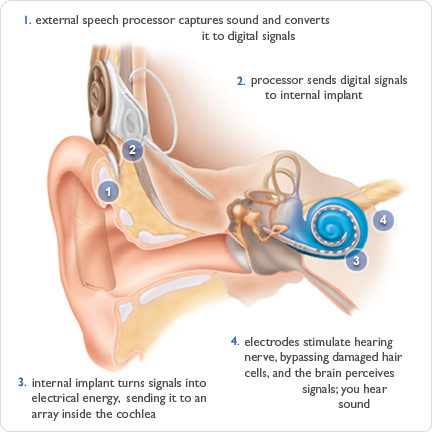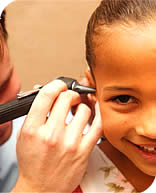Cochlear Implant Center
Cochlear Implant Center at the
University of California Irvine Medical Center
 The cochlear implant is a device for restoration of hearing when a hearing aid is not enough or no hearing exists. It is the only medical technology able to functionally restore a human sense – Hearing. It works differently from a hearing aid in that it does not amplify the sound, but actually replaces the function of hearing by taking in the sound and sending the sound signal to the hearing nerve. The cochlear implant team at UC Irvine has several patents in the design and invention of cochlear implants and have done pioneering surgery in the area. We have had a large number of "super performers" whose performance after surgery is far better than the average cochlear implant users.
The cochlear implant is a device for restoration of hearing when a hearing aid is not enough or no hearing exists. It is the only medical technology able to functionally restore a human sense – Hearing. It works differently from a hearing aid in that it does not amplify the sound, but actually replaces the function of hearing by taking in the sound and sending the sound signal to the hearing nerve. The cochlear implant team at UC Irvine has several patents in the design and invention of cochlear implants and have done pioneering surgery in the area. We have had a large number of "super performers" whose performance after surgery is far better than the average cochlear implant users.
Click below to hear some simulations of what a cochlear implant sounds like:
Click below for a video of a recent UC Irvine Cochlear Implant Program Patient.
Click here for a video of cochlear implant surgery by Dr. Djalilian at UC Irvine.
How Does a Cochlear Implant Work?

Picture courtesy of Cochlear Ltd.
Who is a Candidate for a Cochlear Implant?
Young children: 12 months to 17 years
- Profound sensorineural hearing loss (nerve deafness) in both ears
- Lack of progress in development of hearing skills and language development with hearing aid
- High motivation and realistic expectations from family
- No other medical conditions that will interfere with the placement of the implant
Adults: 18 years and over
- Severe-to-profound sensorineural (nerve deafness) hearing loss in both ears
- Receive little or no useful benefit from hearing aids
- Score 50 percent or less on sentence recognition tests in the ear to be implanted and 60 percent or less in the non-implanted ear or bilaterally.
What Does the Evaluation Process Involve?
Audiological Evaluation
- Specialized hearing testing is performed to evaluate the degree of hearing loss and your ability to understand speech
- If you have hearing aids, your hearing aids are evaluated to assure they are the best fit for your hearing loss
- Further testing with your hearing aids are performed to see how the hearing aid(s) compare to the anticipated results from an implant
- If it is determined that the cochlear implant can provide better hearing for you than your hearing aids, you are deemed a candidate
Cochlear Implant Consultation
- Your medical evaluation starts with a consultation with one of our neurotologists, Dr. Djalilian or Dr. Lin.
- A careful history will be obtained looking into the cause and duration of the hearing loss, ability and mode of communication
- Complete examination of the head and neck
- Consultation with an ophthalmologist or geneticist may be needed
- If the medical evaluation reveals that you are a candidate, imaging is performed
Imaging Studies
- A CT scan (3-dimensional x-ray) of your ear (temporal) bone is obtained)
- Sometimes an MRI (special imaging) of the hearing nerves is needed
Insurance Approval
- Obtaining insurance approval is sometimes the longest step in the process. Our expert re-imbursement specialists contact your insurance company for approval of the procedure.
What Does the Surgery Involve?
Surgery
The surgery involves an approximately 2-hour procedure with an incision behind the ear. A minimal amount of hair is shaved, which is generally not noticeable with the hair down. Some patients stay overnight in the hospital and are discharged to home the day after surgery after removal of the dressing. The pain is generally minimal after surgery.
Click below for a surgery video
The patients are seen after surgery and once everything is healed (a few weeks after surgery), the programming of the implant begins.
What Does the Programming Involve?
Programming
 Once you have healed from the surgery, the process of activation and programming of the device begins. The initial activation is done about 1 month after surgery. Follow-up visits at 3, 6, 9, and 12 months are required for further fine-tuning of the implant sound quality. After the first year, at least one visit a year is needed to insure best performance or for updates in software. For children, more visits are required for rehabilitation.
Once you have healed from the surgery, the process of activation and programming of the device begins. The initial activation is done about 1 month after surgery. Follow-up visits at 3, 6, 9, and 12 months are required for further fine-tuning of the implant sound quality. After the first year, at least one visit a year is needed to insure best performance or for updates in software. For children, more visits are required for rehabilitation.
You may decide to participate in one of our many clinical research projects for improvement of the quality of the implant. Click here to find out more about the ongoing projects at UC Irvine Cochlear Implant Center.
What Does the Rehabilitation Involve?
Rehabilitation
 Once you start hearing with the cochlear implant, the brain needs to learn to understand the sounds that are heard through the implant. Initially, speech sounds differently from the way you used to hear. The process of training the brain to learn the hearing process with the implant is the rehabilitation. While some patients can understand speech well immediately after the initial stimulation and programming, it generally takes some time for the brain to get used to the new way of hearing. The best way to speed up the rehabilitation process is to use the implant during all waking hours of the day. Sometimes, more frequent visits are required for the rehabilitation.
Once you start hearing with the cochlear implant, the brain needs to learn to understand the sounds that are heard through the implant. Initially, speech sounds differently from the way you used to hear. The process of training the brain to learn the hearing process with the implant is the rehabilitation. While some patients can understand speech well immediately after the initial stimulation and programming, it generally takes some time for the brain to get used to the new way of hearing. The best way to speed up the rehabilitation process is to use the implant during all waking hours of the day. Sometimes, more frequent visits are required for the rehabilitation.
For children, weekly visits are required for speech and language training.
To Make an Appointment with Drs. Djalilian or Lin, Please Call 714-456-7017 or click here to request an appointment via the web.

